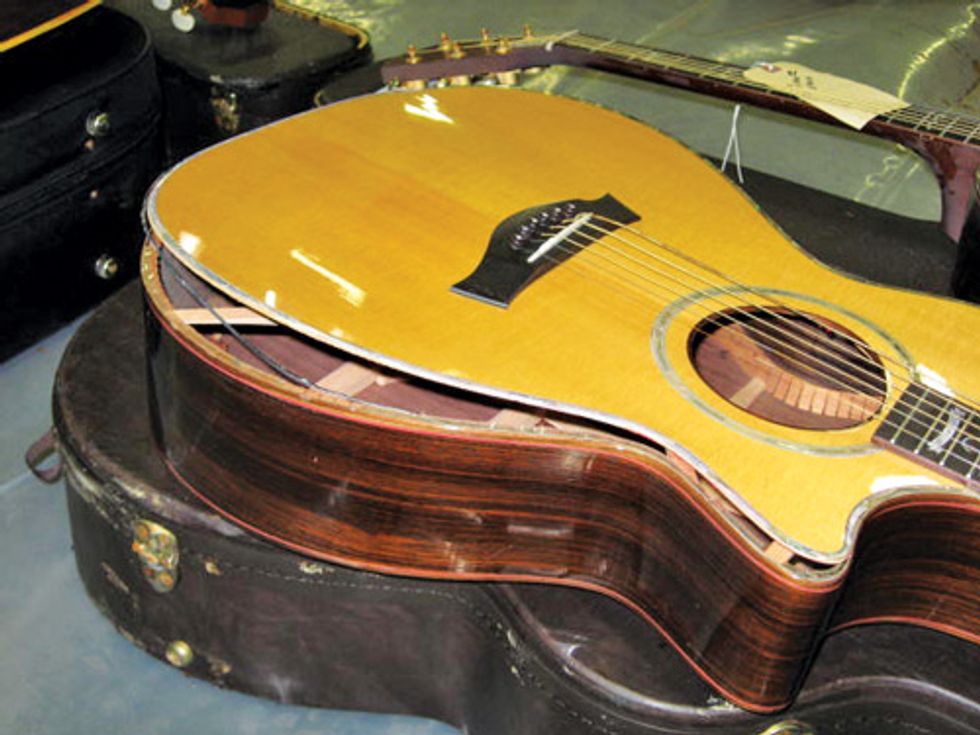Very few Nashville musicians escaped Mother
Nature’s wrath in May when flood waters rose
52 feet above normal in the time it takes to
listen to Pink Floyd’s Dark Side of the Moon.
Located on the banks of the Cumberland
River, Soundcheck is a sprawling complex
housing many rehearsal spaces and storage
facilities for a host of musicians, ranging from
session men to outright superstars. A virtual
who’s who of the music industry lost priceless
guitars and vintage amps in the flood.

After being submerged in flood waters for several days, many acoustics, like this Takamine, fell apart at the seams.
I wrote my very first article for Premier Guitar some time back on my guitar rig. It included two Kustom 72 Coupe heads, one 4x12 Kustom cabinet loaded with Celestions, a Roland GP-8, a DigiTech IPS-33B harmonizer, and a Boss SX-700 multi-effects processor. My amp rack and cabinet were all lost to the rising water. It was heartbreaking to see them ruined, and even harder to throw them in the dumpster.
The good news was that several of my guitars actually survived the ordeal. My Gibson Les Paul Standard, which was repaired several years ago after having its headstock broken off by airline monkeys, is once again in the capable hands of the Gibson Custom Shop to be fixed. The body was still sound and mea sured only 10 percent moisture, according to a fancy gadget that looked very much like a drywall hanger’s stud finder. Steve Christmas with Gibson’s Custom Shop told me that normally when a guitar leaves the factory its moisture content is in the neighborhood of 5 to 8 percent, so mine fared pretty well at warding off the moisture. Once it dries out enough, Gibson will replace the rusted hardware and pickups and my classic Paul will live to rock arenas worldwide once more. The treatment from the soaking actually gave the guitar a vintage distressed look that normally would cost hundreds of dollars to achieve at the shop.
Many of my Paul Reed Smith guitars also faired quite well. My honeyburst McCarty is made of mahogany with a maple top and has an unfinished Brazilian rosewood neck. When I got to it, I noticed a small crack in the finish on the top and a little bit of rust on some of the hardware. Aside from that, you couldn’t tell it had been damaged at all. My PRS Swamp Ash Special was not as accustomed to living in a "swamp" as the name might indicate. Made of softer wood, the Swamp Ash Special split open and separated at the neck joint. My artist rep at PRS said they were able to save many of their guitars after Katrina ripped through New Orleans, so regardless of its injuries, I sent the guitar in for them to evaluate. As of now, they’ve sealed the cracks and are treating the neck joint, in hopes that it will return to a playable state.
The guitar that surprised me the most was my PRS Singlecut Hollowbody. It has a set of custom humbuckers as well as the patented PRS/LR Baggs Piezo System under the bridge, allowing you to simultaneously plug into a PA or recording console and an amp. I use it to cover both the acoustic and electric parts on Toby Keith’s hit, "American Ride." With its thin top and f-holes, I thought for sure it was a goner. Much to my surprise, it faired better than all the others. I noticed some mildew inside the body, and, naturally, all of the electronics had rusted, but other than that there was no visible damage to the body. The wood grain had lifted, giving the soundboard a unique, wavy ridge. As a flood survivor, this guitar is now a one-of-a-kind instrument I will proudly continue to play.
The axes that gave their lives in this ordeal include my Jerry Jones 6-string bass (which will now be retired to a museum that Jerry Jones is going to create to honor his instruments lost in the flood), my Takamine nylon string, which separated where the sides meet the back, and my US Masters Super T, which was a workhorse on the road and in the studio.
It’s really amazing how the Nashville music community pulled together to help each other during this crisis. I’ve been asked to perform in several flood victim fundraisers, and the Nashville Musicians Union Local 257 has started a fund to help replace dam- aged instruments. My personal heroes in this disaster have been Gibson, Kustom, Paul Reed Smith, R&R cases, Takamine, Taylor, Toby Keith, US Masters, and both Bill "Ripp" Mayes and Adam Hudson at the Guitar Center in Nashville. Your help in getting me back on my feet has not been overlooked.
Keep jammin’!
Rich Eckhardt
Rich Eckhardt is a highly sought-after Nashville guitarist who has performed with singers ranging from Steven Tyler to Shania Twain. He currently plays lead guitar for Toby Keith, and also works as a spokesperson for the Soles4Souls charity (soles4souls.org). His new album, Cottage City Firehouse, is available at richeckhardt.com and CDBaby.com













![Rig Rundown: Russian Circles’ Mike Sullivan [2025]](https://www.premierguitar.com/media-library/youtube.jpg?id=62303631&width=1245&height=700&quality=70&coordinates=0%2C0%2C0%2C0)

















